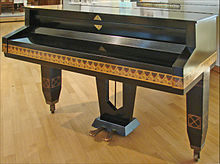Carl Mand

Carl Mand Sr. (* October 27, 1811 in Horchheim ; † August 28, 1892 in Koblenz ) and his son Carl Mand jun. (* July 28, 1846 in Koblenz; † December 26, 1906 in Koblenz) were German piano makers and entrepreneurs .
Company history
The biographical data about Carl Mand sen. are sparse. His father Nikolaus Mand was a carpenter and winemaker in Horchheim near Koblenz. The summer residence of the Berlin banker Mendelssohn, who was occasionally visited by Felix Mendelssohn Bartholdy , was near his court . The Mendelssohn family initially encouraged Carl Mands brother Nikolaus to deepen his knowledge of music and piano making in Vienna . When he died, however, Carl jumped in and began the journey to Vienna, where he had been trained as a piano maker since 1827. After his return he founded his own piano manufacturing company in Koblenz in 1835, which was very successful in the decades to come and exported its instruments all over the world. After Carl Mand sen. After retiring in 1881, his son Carl Mand jun. the sole management. He was appointed purveyor to the court of the German Empress. In 1903 he proudly praised his business as "the only factory in the world that has only won 24 first prizes, including 11 at world exhibitions, in 23 years". Carl Mand jun. died on December 26th, 1906 without offspring. As a result, the company was transformed into a stock corporation Rheinische Pianofortefabriken A.-G. formerly converted to C. Mand . In the same year the company acquired the rival company Heinrich Knauß & Söhne, which had also been based in Koblenz since 1832. In 1911 a third factory was built in Andernach . During this time, around 450 people were employed under the direction of Paul Kappler and over 3000 instruments were produced annually. The First World War and inflation resulted in a sharp decline in production and economic decline, from which the company was only able to recover for a few years after 1923. In 1925 another branch was built in Weilburg and production returned to pre-war levels. However, the global economic crisis that broke out in 1929 led to the cessation of business operations and to the final dissolution of the company on October 13, 1930.
Instruments
Most of Carl Mand's surviving instruments are now in private hands. The Landesmuseum Koblenz maintains a collection in the Ehrenbreitstein Fortress . A grand piano , whose idiosyncratic housing shape was designed by the architect and designer Joseph Maria Olbrich around 1900, is in the Berlin Musical Instrument Museum. There are other models of this octagonal Mand Olbrich grand piano, one in black with elaborate ornamentation is on Mathildenhöhe in Darmstadt . The bell wing and the corner wing, both patents by C. Mand, are also special. These particularly small wings can be placed in corners to save space.
Honors
- 1965: A street in the Koblenz industrial area is named "Carl-Mand-Straße"
- various purveyor titles
- some gold medals and first prizes at world exhibitions
literature
- Conny Restle (Ed.): Fascination Piano. 300 years of piano production in Germany. Munich 2000.
- Wolfgang Schütz: Koblenz heads. People from the city's history - namesake for streets and squares. 2nd revised and expanded edition, Verlag für Werbung Blätter GmbH, Mülheim-Kärlich 2005.
- Energieversorgung Mittelrhein GmbH (ed.): History of the city of Koblenz.
- Volume 1: From the beginning to the end of the electoral era. Theiss, Stuttgart 1992, ISBN 3-8062-0876-X .
- Volume 2: From the French city to the present. Theiss, Stuttgart 1993, ISBN 3-8062-1036-5 .
Web links
[1] Carl-Mand.de
| personal data | |
|---|---|
| SURNAME | Mand, Carl |
| BRIEF DESCRIPTION | German piano maker |
| DATE OF BIRTH | October 27, 1811 |
| PLACE OF BIRTH | Koblenz-Horchheim |
| DATE OF DEATH | August 28, 1892 |
| Place of death | Koblenz |

